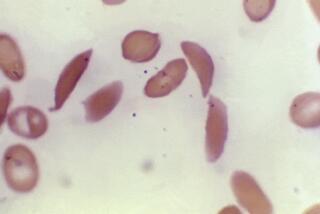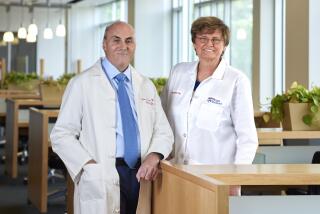Pace of Gene Therapy Experiments Quickens : Medicine: Dramatic success with two girls spurs more attempts. But obstacles to treatments remain high.
Cynthia Cutshall’s parents never expected that she would be able to go to school. Born with a rare genetic disorder called ADA deficiency, the Canton, Ohio, girl had no functioning immune system to protect her from infections. As a result, she suffered chronic sinus problems that often led to near-fatal pneumonia, and seemed destined to live a life of wretched isolation, much like an earlier, more well-known victim of the disease, David, the “boy in the bubble” in Houston, who died at age 12.
Three years ago, however, then-9-year-old Cynthia and 4-year-old Ashanthi DeSilva, who also suffers from the disorder, became the first subjects of a radical, and then controversial, new technique called gene therapy.
Dr. R. Michael Blaese and Dr. Kenneth Culver at the National Cancer Institute, and Dr. W. French Anderson, a geneticist now at USC, removed white blood cells from the girls and inserted a healthy copy of the ADA gene into the cells. They then infused the cells back into the girls’ bloodstreams, where the gene stimulated the production of the missing enzyme.
After several such treatments, the girls have functioning immune systems and are attending public schools. Cynthia is in the sixth grade and loves playing baseball. Ashi, as Ashanthi DeSilva’s parents call her, swims with her friends in suburban Cleveland and loves drawing. Both are serving as “research ambassadors” for the March of Dimes to talk about their experiences and to educate the public on the benefits of gene therapy.
“We are exceptionally pleased with our patients’ progress so far,” Blaese said recently. “But more than anything else,” Anderson said, “the first treatment was a social and cultural victory. It launched the field of human gene therapy.”
Geneticists have long predicted that genetic engineering techniques would be able to produce such dramatic achievements, but few would have predicted the rush of human gene therapy projects that would be initiated in the wake of the success with Cynthia and Ashi.
The National Institutes of Health has approved 48 such projects and 10 are pending, according to NIH’s Office of Recombinant DNA Activities. At least four are in progress in other countries.
Human gene therapy centers are being established throughout the country, including at USC, City of Hope, the University of Michigan and University of Pennsylvania. The fast pace has astonished many researchers.
“Just a year or two ago, I don’t think any of us in the field thought it would move so fast,” said Dr. Albert P. Deisseroth, a medical geneticist at the University of Texas M. D. Anderson Cancer Center in Houston. Even then, many critics were arguing that researchers should perform more studies in animals before plunging headlong into human trials.
“There is no substitute for doing it in man,” said Dr. Gary J. Nabel, a geneticist at the University of Michigan. “Humans are where we really need to go if we are going to have a greater understanding (of gene therapy) and make an impact on disease. If we can learn what’s working and what’s not working, we can improve on it.”
“The idea of doing human gene therapy is now more acceptable,” said molecular biologist Inder Verma of the Salk Institute in La Jolla.
One infant in every 100 is born with a serious disorder caused by a defect in one or more of the 100,000 genes that make up the human genetic complement. The gene--composed of deoxyribonucleic acid, or DNA--is the fundamental unit of heredity.
Usually the damage becomes evident in childhood. “All too often,” Verma said, “it gives rise to physical or mental abnormalities, pain and early death.” Of the more than 4,000 known inherited disorders, most lack fully effective therapies.
In many cases, the only hope for the patients is to insert a healthy version of the defective gene into the diseased cells. Once the gene is there, researchers must induce it to produce a healthy enzyme or other protein to restore normal function. Researchers have made great progress in their attempts to do this, especially in patients like Ashi and Cynthia, although problems remain.
But the correction of such inborn genetic defects is not the only--or even the primary--focus of today’s gene therapists. More than half of all current projects are aimed at cancer and AIDS, the former caused by healthy genes gone awry, the latter caused when viruses insert their genes into healthy cells, causing them to function abnormally.
For the short term, researchers are attempting to add genes to the body’s immune cells to bolster their effectiveness and to help them recognize cancerous and HIV-infected cells and destroy them. For the longer term, geneticists hope to replace defective tumor suppressor genes that have allowed cancers to emerge, thereby preventing cancers from developing in the first place.
Even that is not the end of the possibilities for gene therapy. Many of the most important human diseases, ranging from heart disease and diabetes to arthritis and Alzheimer’s, involve genetic susceptibilities. Genetic engineers hope to eventually be able to prevent many of these diseases by giving people healthy genes to reduce that susceptibility.
Researchers are drawn to all these applications because, at first blush, gene therapy looks easy. “Gene therapy is conceptually simple, but in practice, there are horrendous hurdles to overcome,” said geneticist Richard Samulski of the University of Pittsburgh.
Among those hurdles: targeting the gene to specific cells; producing large enough quantities of the previously missing protein to cure, or at least ameliorate, the disease, and sustaining production of the missing protein produced by the target cells for more than a few weeks so that the patient does not have to be continually re-treated.
But the demonstrated successes of gene therapy are luring many new investigators, who are making impressive progress on these fronts. These “clever applications . . . ensure that gene therapy will be applied to a broad range of diseases over the next several years,” Anderson said.
But until gene-carrying agents “can safely and efficiently be injected directly into patients as drugs like insulin are now,” he added, gene therapy will be able to help “only thousands, not millions, of patients.”
*
As of now, replacing even one gene is difficult. The most common approach involves using a virus to insert the desired gene into the target cell’s DNA. But not just any virus will do. Because most viruses do not insert their own genes into the target cell, most are useless for gene therapy.
The primary exceptions are retroviruses, which can insert their genes into the DNA of an infected cell. Retroviruses include animal cancer viruses, HTLV--which causes certain rare leukemias in humans--and the human immunodeficiency virus or HIV, which causes AIDS. All of these viruses--rendered harmless by genetic engineering--are being used for gene therapy in humans or in animal studies. “Retroviruses are the most promising gene delivery system studied so far,” Verma said.
Many investigators started working with retroviruses, such as the mouse leukemia virus, in the early 1980s. The first step is to defang the virus by removing the genes that allow the virus to reproduce in the cell and those that cause cancer. In place of these viral genes, researchers insert the human gene or genes that they wish to use.
That’s the easy part. Researchers then must grow adequate quantities of the virus--no easy task because the genes that allow it to replicate have been removed--and prove that it is safe.
One fear is that the altered viruses will regain the ability to replicate. Most researchers had not particularly worried about such an event: They commonly use mouse viruses for gene therapy because they believe that such viruses could not cause disease in humans--a view that was seemingly upheld by studies in the mid-1980s.
Thus, researchers were shocked two years ago when three of eight rhesus monkeys used by molecular biologist Arthur Nienhuis of the National Heart, Lung and Blood Institute in a gene transfer experiment developed lymphoma, a cancer of the lymphatic glands. Nienhuis knew the retrovirus preparation contained viruses capable of replication, but experience had led him to assume they were harmless.
That experience has prompted the U.S. Food and Drug Administration to expand the amount of testing required for retroviral preparations before they are used in humans in order to ensure that no viable viruses are present. Some critics of gene therapy argue that the viruses could recombine with others present in humans to form lethal viruses.
Molecular biologist Richard Mulligan of the Massachusetts Institute of Technology notes that “outbreaks” of infectious viruses have occurred in cell lines used to prepare retroviruses. He urges that greater efforts be made to determine how to prevent the formation of such infectious viruses before retroviruses are used for therapy in humans. Most researchers consider retrovirus-initiated disease unlikely, however, and so far no disease has been attributed to gene therapy.
Perhaps a bigger problem is that retroviruses can infect only cells that are in the process of dividing, sharply limiting the number of cells in the body that can be targeted. Blood cells, skin cells called fibroblasts, liver cells and a few others present the primary opportunities. Brain and muscle cells are among the many that do not divide.
Furthermore, only a small fraction of the dividing cells exposed to the altered retroviruses are infected--typically between 3% and 10%. And even if the gene is successfully inserted into target cells, it may turn itself off after a few days or weeks so that it no longer produces the desired protein. Molecular biologists are actively attacking these problems.
Because of fears that viable retroviruses would be formed in humans, a majority of researchers have so far chosen to treat patients’ cells outside the body and then reinfuse them. In the case of Cynthia, Ashi and two other children treated by Blaese and his colleagues, this process worked well. Despite the fact that only a small fraction of cells were infected by the inserted retroviruses, enough ADA was produced to restore immunity. Researchers in other countries have obtained similar results in severe combined immunodeficiency disease (SCID) and hemophilia, a bleeding disorder.
Unfortunately, the infused cells, like all normal white cells, are slowly cleared from the bloodstream, so the process has had to be repeated every three to six months. To circumvent this problem, Blaese, Culver and Anderson in May used the same procedure to treat the girls’ stem cells--the primitive parent cells from which all other blood cells are formed. A similar procedure was performed on three newborns with SCID, two in San Francisco and one in Los Angeles, the same month.
Theoretically, if stem cells were subjected to gene therapy, the result would be a “cure” because they would provide a continuous supply of healthy cells for the rest of the patient’s life. But they are present only in very small quantities and special procedures are necessary to harvest them.
It is not clear whether the stem cell treatment was successful in the patients.
Another example of successful gene therapy involves patients with familial hypercholesterolemia, a liver disorder that results in extreme cholesterol buildup and early death.
To treat these patients, Dr. James M. Wilson, a geneticist at the University of Michigan, removes about 15% of the patient’s liver, separates individual cells and inserts the healthy gene for a protein called an LDL receptor. LDL, or low-density lipoprotein, is the so-called bad form of cholesterol whose presence in the blood in high quantities increases the risk of heart disease. When the cells are infused back into the patient, they take up residence in the liver, and the LDL receptor on their surface allows them to remove cholesterol from the recipient’s blood.
Wilson performed the first treatment in June, 1992, on a 29-year-old Quebec, Canada, woman who had such severe coronary disease that bypass grafts were failing after only three years. He reported in February that her cholesterol level, initially three times normal, had been reduced nearly 40%. He hopes to bring it into the normal range with conventional drugs. Wilson, now at the University of Pennsylvania, is treating four more patients.
A similar approach of engineering cells outside the body has been used in most searches for cures to cancer and AIDS. In each case, the goal is to get the immune system to attack the tumors more vigorously.
Some of these approaches involve adding the genes for therapeutic proteins to a patient’s white cells to increase their ability to attack cancerous or HIV-infected cells. Others involve attaching easily recognizable protein markers to cancer cells, so that the immune system attacks them more readily.
So far, these “cancer vaccines” have proved safe, but it is not clear if they are effective. In August, however, Dr. Claudio Bordignon of the Institute of Scientific Research in Milan, Italy, reported that he had used such a vaccine to cure a 29-year-old woman of lymphoma, a tumor of the lymph glands. Bordignon said this was the first reported cancer cure by gene therapy.
Because retroviruses infect only cells that are dividing rapidly, researchers must use other techniques to treat those that reproduce slowly, such as lung cells. This year, Wilson, Dr. Ronald G. Crystal, a geneticist at the National Heart, Lung and Blood Institute, and Dr. Michael J. Welsh of the University of Iowa each began treating cystic fibrosis patients with genetically engineered adenoviruses. These viruses are one of the many causes of the common cold and normally target nasal passages and the lungs, although they do not insert their genes into the host cell’s DNA.
Cystic fibrosis patients have a defective version of a gene called CFTR that allows thick mucus to build up in the lungs, where it impairs breathing and traps bacteria that can cause lethal infections. The researchers insert a healthy copy of the gene into a defanged adenovirus, which is then sprayed into the patients’ nasal passage and lungs. The researchers predict that infecting just 10% of cells in these areas could significantly alleviate cystic fibrosis symptoms.
Welsh reported last month that the procedure was safe and could cure the cystic fibrosis biochemical defect in treated nose tissues, providing “a foundation for moving forward to test whether gene therapy can provide clinical improvement for the patient.”
Crystal, however, had to stop treating one woman who was receiving a high dose of the altered virus after she developed lung inflammation, fever and a drop in the oxygen levels in her blood. The symptoms disappeared within a week, but Crystal and Wilson have decided to use only lower levels of virus for now.
Researchers are planning a variety of other approaches as well, such as encapsulating genes in fatty globules that they hope will be taken up by diseased cells. Michigan’s Nabel and others, such as molecular biologist Robert J. Debs of UC San Francisco, hope that these globules, called liposomes, will present fewer safety hazards than viruses and that they will be useful on a much wider variety of cells.
Meanwhile, Ashi and Cynthia are playing the games that little girls play and enjoying the company of newfound friends. And that, perhaps, is the strongest recommendation of all for human gene therapy.
Targets of Gene Therapy (Orange County Edition, A3)
Geneticists have long predicted that genetic engineering techniques would be able to produce dramatic achievements, but few would have anticipated the rush of recent projects. Some examples of new treatments for diseases:
Cystic fibrosis: The healthy CF gene is inserted into a common cold virus, called an adenovirus. The virus is sprayed into the nasal passage and lungs, where it infects cells and produces the missing protein.
Severe combined immunodeficiency disease: White cells are extracted from blood and treated with a mouse leukemia virus that inserts the gene for the missing protein, adenosine deaminase. When the white cells are reinfused in the body, they produce the missing protein and restore immune function.
Familial hypercholesterolemia: Researchers combat the disease, which produces a massive buildup of cholesterol, by removing about 15% of the liver, separating the cells and using a mouse leukemia virus to insert the gene for a missing protein called the LDL receptor. When the altered cells are infused back into the body, they accumulate in the liver and remove cholesterol from the blood.
Advanced cancers: White blood cells are removed from the tumor site. Then researchers insert the gene for anti-tumor agents and grow large numbers of the cells. The cells are reinfused to fight the tumor.
Melanoma: Circular strings of DNA called plasmids, encased in fat globules, are inserted directly into tumors. The DNA inserts the gene for a so-called transplantation antigen that makes the body reject the tumor as it would a transplanted organ.
AIDS: HIV-infected white blood cells are removed and treated with a mouse leukemia virus so they can be more easily recognized by the immune system. When reinjected, the cells stimulate a stronger immune attack on other HIV-infected cells.






